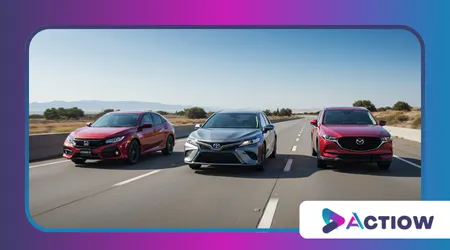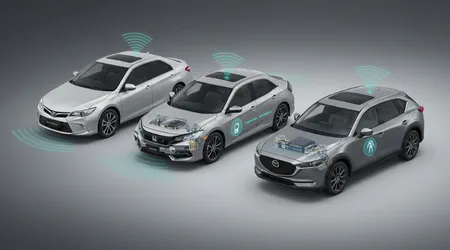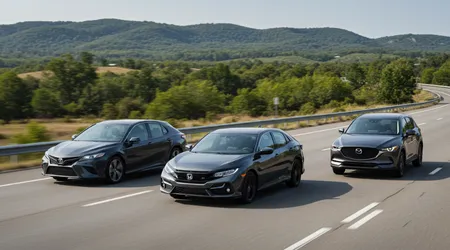Cars with the Best Safety Features in 2025: Technologies That Protect

Anúncios
In 2025, cars with the best safety features dominate the automotive landscape, blending cutting-edge tech with real-world protection.
Imagine driving a vehicle that not only shields you from harm but anticipates danger before it strikes.
Today’s roads demand more than just airbags and seatbelts, they crave intelligent systems that adapt, react, and even prevent collisions.
Anúncios
From electric sedans to rugged SUVs, manufacturers race to outdo each other, prioritizing your safety above all else. This isn’t just about surviving a crash it’s about avoiding one entirely.
Why does this matter now?
The stakes have never been higher, with traffic fatalities still a global concern despite technological leaps.
In 2025, the focus shifts to rear-seat passengers, pedestrians, and even cyclists, thanks to stricter standards from bodies like the Insurance Institute for Highway Safety (IIHS).
These advancements aren’t mere gimmicks, they’re lifesavers, rooted in data and driven by innovation.
Whether you’re a parent hauling kids or a commuter dodging rush-hour chaos, the right car can make all the difference.
This deep dive explores the standout vehicles and technologies redefining safety in 2025.
We’ll unpack crash-test champs, dissect driver-assistance marvels, and spotlight what keeps you secure behind the wheel.
Buckle up because safety isn’t just a feature, it’s a revolution, and we’re here to guide you through it with clarity and a touch of excitement.
Why Safety Matters More Than Ever in 2025
Picture this: you’re cruising down a highway when a distracted driver swerves into your lane.
Modern cars don’t just brace for impact they intervene, steering you clear with split-second precision. Safety in 2025 isn’t optional, it’s essential, as urban sprawl and distracted driving push accident rates higher.
The IIHS reports tougher crash tests this year, emphasizing rear-seat protection a game-changer for families.
++ Volkswagen Golf GTI vs Honda Civic Type R: Hot Hatches Face Off
Beyond statistics, it’s personal your loved ones deserve a fortress on wheels, not a gamble.
Automakers know this, pouring billions into research, from reinforced frames to AI-driven alerts.
Electric vehicles join the fray, proving eco-friendly doesn’t mean flimsy, with models like the Hyundai Ioniq 6 leading the charge. Safety’s evolution reflects our lives: faster, smarter, and more connected than ever.

Top Cars Redefining Safety Standards
Let’s spotlight the heavy hitters cars with the best safety features that ace 2025’s brutal crash tests.
The Toyota Camry, a midsize sedan icon, blends hybrid efficiency with top-tier protection, earning IIHS Top Safety Pick+ honors. Its secret?
A suite of sensors that detect everything from jaywalkers to jackknifing trucks.
Then there’s the Honda Civic hatchback, a compact titan with a five-star NHTSA rating and agile collision avoidance.
Also read: Cars with the Most Interior Space in 2025: Comfort Guaranteed
Don’t sleep on the Mazda3 sedan either its sleek design hides a steel backbone, scoring perfect marks in side-impact trials. These aren’t just cars, they’re rolling sanctuaries built to outsmart danger.
SUVs aren’t left behind the Mazda CX-50 combines rugged charm with advanced lane-keeping tech, perfect for unpredictable terrain.
Meanwhile, the Hyundai Tucson proves midsize crossovers can prioritize safety without breaking the bank, boasting pedestrian detection that rivals luxury brands.
Each model pushes boundaries, proving safety isn’t a luxury it’s standard.
Crash-Test Champions: What the Data Says
Numbers don’t lie, and in 2025, the IIHS and NHTSA data paint a vivid picture of safety excellence.
The Honda Accord earns a rare “Good” rating in the updated moderate overlap front test, protecting rear passengers like never before.
Toyota’s Camry follows suit, with a 5-star NHTSA score across all categories.
Read more: Land Rover Defender vs Jeep Wrangler – Adventure Guaranteed
Check out this breakdown of top performers in Table 1 below crash-test ratings tell the tale of survival odds.
The Hyundai Ioniq 6, an electric standout, nails pedestrian crash prevention, scoring “Acceptable” in both day and night tests.
These stats aren’t just bragging rights, they’re your shield on the road.
| Table 1: 2025 Crash-Test Ratings | IIHS Rating | NHTSA Overall |
|---|---|---|
| Toyota Camry | Top Safety Pick+ | 5 Stars |
| Honda Civic Hatchback | Top Safety Pick+ | 5 Stars |
| Hyundai Ioniq 6 | Top Safety Pick+ | 4 Stars (Front) |
| Mazda CX-50 | Top Safety Pick+ | 5 Stars |
Cutting-Edge Safety Technologies Unveiled
Dive into the tech toolbox of 2025 cars with the best safety features lean hard into innovation.
Adaptive Cruise Control (ACC) evolves, now syncing with traffic flow and braking instinctively in jams think Toyota’s Traffic Jam Assist.
Automatic Emergency Braking (AEB) gets smarter too, spotting cyclists in the dark, a staple in the Mazda3.
Lane-Keeping Assist isn’t just a nudge anymore it’s a lifeline, gently steering you back on course, as seen in the Honda Civic.
Nighttime pedestrian detection shines in the Hyundai Tucson, using infrared cameras to pierce the gloom. These aren’t sci-fi dreams, they’re here, keeping you one step ahead of chaos.
Augmented reality creeps in too head-up displays in the Acura Integra project warnings onto your windshield, minimizing distraction.
Intersection Assist, featured in the Kia EV6, brakes for cross-traffic you didn’t see coming. It’s not just about reacting, it’s about predicting and that’s where 2025’s tech truly flexes.
Electric Vehicles: Safety Meets Sustainability
Electric doesn’t mean fragile EVs in 2025 are safety powerhouses, merging green vibes with hardcore protection.
The Hyundai Ioniq 6 pairs a low center of gravity with stellar crash scores, its battery pack doubling as structural muscle.
Tesla’s Model Y, despite a reliability dip, holds a five-star NHTSA badge, thanks to Autopilot’s vigilance.
Consider the Subaru Solterra its all-wheel-drive grip and Top Safety Pick+ status make it a winter warrior. EVs bring unique perks: silent operation alerts pedestrians via artificial sound, while heavy frames absorb impacts better.
Sustainability meets survival, proving you can save the planet and yourself in one ride.
Range anxiety fades as safety rises the Genesis GV60 boasts remote parking assist, easing tight spots without a scratch.
These electric marvels don’t compromise, they elevate, blending eco-consciousness with tech that watches your back.
It’s a win-win for drivers who care about both Earth and their passengers.
Driver Assistance: Your Co-Pilot on the Road
Forget passive safety 2025’s driver assistance systems are proactive guardians, transforming every trip.
Blind-Spot Monitoring in the Toyota Camry flashes alerts, nixing lane-change guesswork, while Rear Cross-Traffic Alert saves you in parking lot scrambles.
Adaptive headlights, like those in the Mazda CX-50, bend with curves, illuminating hidden threats.
Ever tried Honda’s LaneWatch? A camera beams your blind spot to the dash genius for city weaving.
The Kia EV6 ups the ante with Highway Driving Assist, blending steering and speed control for stress-free hauls. These tools don’t just assist, they empower, turning average drivers into road masters.
Real-world example: a parent dodging a runaway stroller credits the Tucson’s AEB for a near-miss save.
Consumer Reports notes 82% of drivers now demand these features proof they’re not fluff, but must-haves.
Your car’s not just a ride, it’s a partner, anticipating trouble before you blink.
Family-Friendly Safety: Protecting What Matters Most
For families, safety isn’t negotiable cars with the best safety features cater to kids and chaos alike.
The Honda Odyssey minivan shines with rear-seat alerts, ensuring no child’s left behind, plus a five-star side-impact rating. Toyota’s Sienna hybrid adds AEB with cyclist detection, perfect for suburban sprawls.
SUVs like the Mazda CX-90 PHEV offer three-row security, with ISOFIX anchors that lock car seats tight.
A mom in Seattle swears by its blind-spot cameras, dodging bikes on rainy days. These rides blend practicality with peace of mind, shielding your crew from the unexpected.
Table 2 below highlights family-focused safety scores check the Odyssey’s near-perfect marks.
The Subaru Forester, sans Wilderness trim, nails child occupant protection at 90%, per Euro NCAP.
It’s not just about crash survival, it’s about thriving through daily madness with confidence.
| Table 2: Family Safety Scores (2025) | Child Protection (Euro NCAP) | Rear-Seat Features |
|---|---|---|
| Honda Odyssey | 88% | Rear-Seat Alert |
| Toyota Sienna | 85% | Cyclist Detection |
| Mazda CX-90 PHEV | 87% | Blind-Spot Cameras |
| Subaru Forester | 90% | ISOFIX Anchors |
Luxury Meets Safety: Premium Protection
Luxury isn’t just leather seats it’s survival, and 2025’s upscale rides deliver.
The Genesis G90, a large sedan beast, aces IIHS tests with a reinforced cage and night-vision assist pricey, but priceless in a storm.
Acura’s Integra blends sporty flair with traffic-jam assist, keeping you calm in gridlock.
Volvo’s XC90 PHEV stays true to its safety-first legacy, with cyclist-aware AEB and a plush cabin that cocoons you. A CEO I met raved about its lane-centering on long hauls luxury that works overtime.
These cars prove high-end doesn’t skimp on shielding you from harm.
Challenges and Trade-Offs in Safety Tech
Perfection’s a myth even the best safety tech has quirks worth weighing.
Adaptive systems like ACC can lag in sudden downpours, as a Tucson owner learned during a flash flood sensors aren’t foolproof.
Reliability varies too; Consumer Reports flags Rivian’s R1S at 9/100 despite its Top Safety Pick+ nod.
Cost creeps up fully loaded safety suites jack up prices, leaving base models leaner on features.
A Camry hybrid owner shrugged off glitchy lane assist, but praised its crash scores trade-offs depend on priorities. Tech’s a tool, not a cure-all, so know its limits before you commit.
Complexity’s another hurdle too many alerts can overwhelm, like the Integra’s beeping frenzy in traffic. Balance matters: a safe car shouldn’t babysit you into distraction.
Manufacturers tweak these kinks yearly, but for now, it’s a dance between innovation and real-world grit.

The Future of Automotive Safety
Peering ahead, 2025’s safety breakthroughs hint at wilder horizons think cars that talk to each other.
Vehicle-to-Vehicle (V2V) communication trials promise collision warnings miles out, a tech the NHTSA’s fast-tracking for 2030.
Autonomous driving looms too, with Tesla refining Autopilot daily.
Imagine pedestrian airbags popping outside the hood, or AI predicting your drowsy swerve prototypes exist, and they’re close.
Safety’s not static, it’s a sprint, fueled by data like the IIHS’s 2025 rear-seat focus shift. Your next car might not just protect it’ll outthink the road itself.
Final Thoughts: Choosing Your Safety Champion
So, where does this leave you?
Cars with the best safety features in 2025 offer more than steel and airbags they’re lifelines, tailored to your world.
Whether it’s the Camry’s hybrid hustle, the Civic’s compact grit, or the Ioniq 6’s electric edge, options abound. Pick what fits family hauler or solo cruiser, luxury or budget.
Reflect on this: the IIHS saved 78,000 lives by 2017 through crash-test rigor today’s tech pushes that legacy further.
Test-drive these beasts, feel the assist systems hum, and trust the data your ride’s your armor. Safety’s not a buzzword, it’s your ticket to fearless roads.
Don’t just buy a car invest in survival, because 2025’s roads reward the prepared.
From EVs to minivans, the choices dazzle, but the goal’s simple: get home safe, every time.
Let these innovations steer you toward confidence, not just a parking spot drive the future, starting now.
